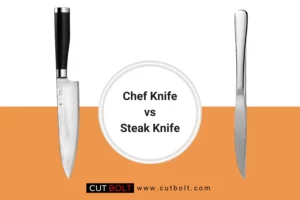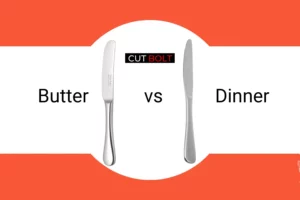Santoku vs Nakiri – which one to use? When it comes to buying a Japanese kitchen knife, the question is which one to buy? It can be quite confusing. There are many different types of Japanese knives available on the market, each with their own unique features and advantages.
Which one should you choose? The answer is simple; it depends on what you want to do with the knife.
Nakiri vs Santoku knife
It is obvious; nakiri knife and the Santoku knife have many differences. The only similarity between them is they both originated from Japan. We will learn more about these Japanese knives in detail in our Nakiri vs Santoku guide here:

What is a Nakiri knife
In Japanese Nakiri knife (Nakiri bocho) means a leaf cutter / a knife for cutting greens, or a knife for cutting vegetables.
Japanese knife makers use a simple, minimalist design for their vegetable knives, making them easy to use and maneuver. A culinary knife is designed to have a blade that’s sturdy, flexible, and easy to sharpen for use in the kitchen. The best ones have a handle that’s easy to hold and grip with your fingers, a comfortable shape to fit your hand, and a durable sharp blade.
A nakiri knife is usually made from a single piece of high-carbon steel. The edge of the blade is honed to a single cutting edge, making the knife extremely sharp. It’s the perfect knife for slicing, dicing, and mincing vegetables.
The advantage of using a nakiri knife over other types of knives is that it doesn’t need any special training to master. A beginner can pick up a nakiri knife and immediately start chopping. It is a great knife to use for beginners.
Another reason why nakiri knives are so popular is that they are easy to sharpen. This makes them perfect for home cooks. They also have a low cost per use.
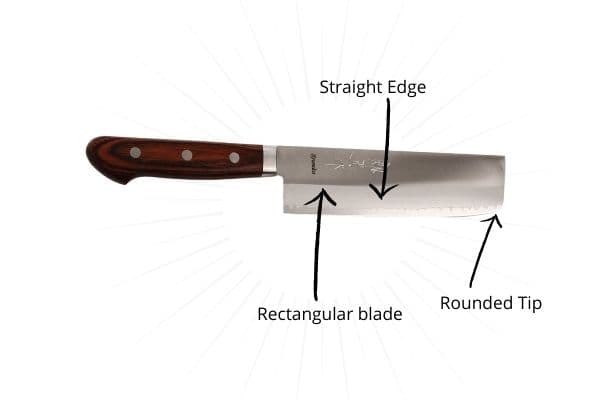
The shape of a Nakiri knife
The shape of the blade is good for vertical chops or pull cuts. The nakiri is a great fit because of the knife’s thin blade and the way it cuts the leaves of vegetables. With a thinner blade, it is ideal for cutting the leaves of vegetables while retaining their crispiness. You don’t want to waste your greens by ripping them. Instead, have precision cut.
You will notice, unlike chef knife, santoku knife, or many other knives, nakiri knife does not have a pointed tip. It has a blunted, flat end. This blade type is not suitable for cutting meat or navigating between bones. Nakiri knife does what its name says – cut vegetables.
What is a Nakiri knife used for?
What are the uses of a nakiri knife? The nakiri vegetable knife is used for cutting vegetables. The most important feature of the nakiri vegetable knife is that its long, flat edge allows you to make a single cutting action all the way through to your chopping board. Also, this knife has a double bevel or double side, meaning that both sides of its edge are sharpened and can be taken up in either the left or right hand.
The nakiri is an excellent choice for chopping root vegetables, especially those that take a long time to cook. Its long, straight blade easily penetrates into vegetables, allowing you to make clean, easy, uniform cuts. It’s great for hard root vegetables such as carrots, celery and beets. One of the key features of the nakiri vegetable knife is the balance between the rectangular blade and the slender, simple handle.
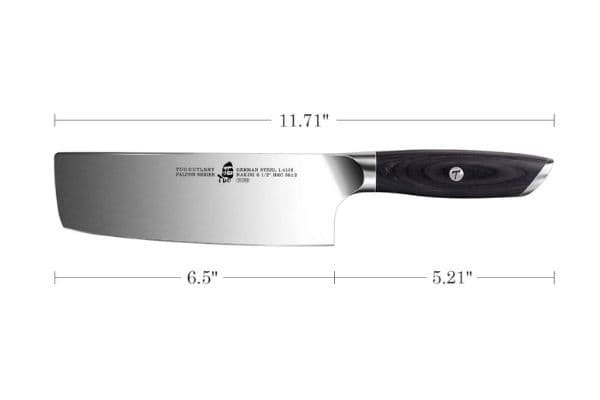
Look at the handle. Picture yourself holding the nakiri in your hands. Imagine how the shape of it, with a longer handle and a blade slightly shorter than normal, allows you to easily go through root vegetables, chopping them into smaller pieces with unparalleled balance.
A good nakiri knife is an essential part of any home kitchen. It’s crafted from high-quality materials, built with a purpose, and works with a minimum of fuss and a maximum of enjoyment. It’s reliable, balanced, versatile, efficient, and easy to clean up.
This is a good vegetable knife for Western, Japanese, Korean, or any other Eastern cuisine. A nakiri knife is easy to maintain than other professional knives in the kitchen.
Articles you might like:
What is a Santoku knife?
On the contrary to a nakiri knife, a santoku knife is for cutting meat, fish or vegetable (a multi-purpose knife).
The best all-purpose chefs’ knife is a Santoku. It’s a versatile blade that can be used for everything from cutting meat and vegetables to chopping and slicing. The name ‘Santoku’ translates as ‘three qualities’, or three virtues. Some people think it means the knife is good for cutting meat, fish and vegetables; others think it means it’s equally good for chopping, slicing and dicing.
A true workhorse, the Santoku knife is not only highly versatile but also extremely easy to use. It’s unique ‘sheepsfoot’ blade design means it’s perfect for slicing, chopping and dicing, and can be used for any job at hand.
There are several different styles of Santoku knives with varying tip designs. Some have a fully rounded tip, while others have a sharp point like a chef’s knife. But while it’s best suited to your everyday kitchen tasks, it’s also great for more advanced techniques.
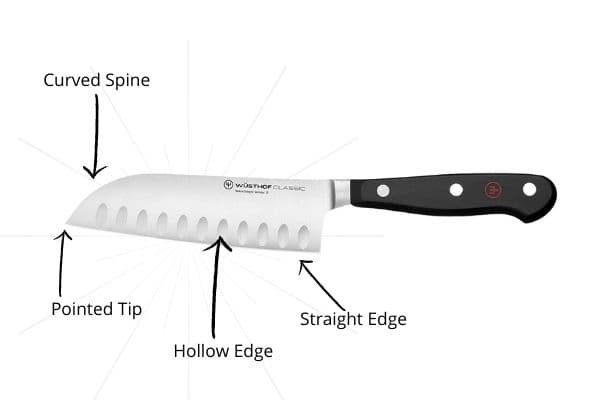
Origin of Santoku Knife
The Santoku knife, as you probably guessed, is from Japan. It’s not exactly a “traditional” cutlery tool, having only been made available commercially in the last 50 years (after WW-II). But it’s a great all-purpose kitchen knife that’s very versatile and does everything a regular knife can do and more. Santoku knife was created as an alternative to Nakiri, with more versatile use.
How Santoku gained popularity
As we have mentioned earlier production of Santoku knives started after World War II. Before that Japanese people used a Nakiri to cut vegetables, a Deba to cut fish, and a Gyuto to cut meat.
The Santoku knife was made to merge these three knives into one, the result is a multi-purpose knife. Santoku knife did not entirely replace the use of nakiri, deba and gyuto knives. But it became popular among chefs due to its versatility, lightweight, and user-friendly nature.
Santoku already was a workhorse with a thinner blade, precision cut and less weight. In the early 2000’s American celebrity chef Rachael Domenica Ray announced that she loves the Wusthof knife. Which happened to be a Santoku. Overnight it became a super sensation in America. All the popular knife makers around the world started making their own version of Santoku (keeping the original flavor intact).
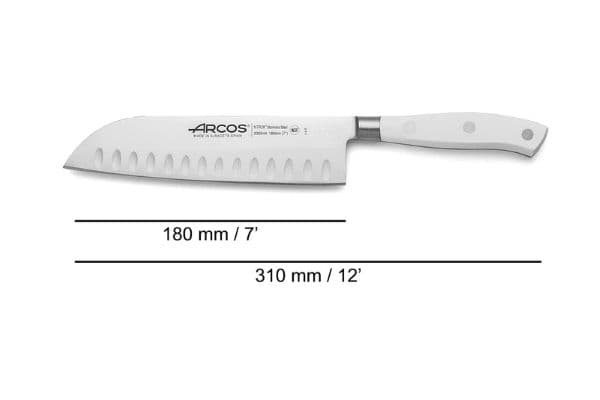
Size of a Santoku knife:
The Japanese Santoku knife is shorter and lighter than its Western-style counterparts. It’s designed with more balanced weight distribution and is ideal for slicing and dicing foods.
There are many types of knives. The standard Santoku knife is about five to eight inches long. It has a curved front and a gentle tip. Most Santoku knives have a scalloped cutting edge to prevent food from sticking to the blade.
What is a Santoku knife used for?
The cutting edge of a Santoku knife is very close to being straight, so you can slice much finer than with other knives. It has a thinner blade, so it’s also easier to chop foods like mushrooms or carrots. It’s wider (so it can scoop up chopped vegetables or scoop out sliced meats), so it’s perfect for scooping up ingredients while cooking.
A Santoku is faster and more efficient than a chef’s knife because it has a straight cutting edge. The straight cutting edge of the santoku allows you to make a complete cut in just one smooth downward motion.
There are many knives out there that claim to have a sharpening angle of 15 degrees or more. The Santoku knife really does, it has a 12-15 degrees sharp angle. With a single bevel blade, it’s able to be sharpened to a smaller angle of 15 degrees, giving you superior cutting ability. You will find santoku knives with single and double bevel blades. The blade is thin and light-weight, giving you a better grip on the heel of the blade. This makes it easier to cut through foods with the Santoku knife.
In addition to making it safer and easier to use, the wide blade also allows you to get your fingers close to the blade, which makes it easier to cut faster (a wide blade keeps your fingertips and knuckles safe during fast operation). A traditional Santoku knife is made of Japanese steel which is heavier than the new, lighter material used in some knives.
Also Read: Carbon vs Stainless steel knife
What to look for while buying a Santoku knife?
The best kitchen knife for your needs depends on many factors such as the kind of food you prepare, your technique, the size of your hands, and how big or small your kitchen workspace is.
When choosing the best santoku knife, you’ll want to consider what type of job you’ll use it for and which features you’ll need.
Sharpness: There is no shortcut to becoming an excellent chef. It’s all about having a deep passion for cooking and learning the fine art of knife skills. Pick up a sharp knife out of the box, you’ll have a great head-start when the time comes to hone your knife skills.
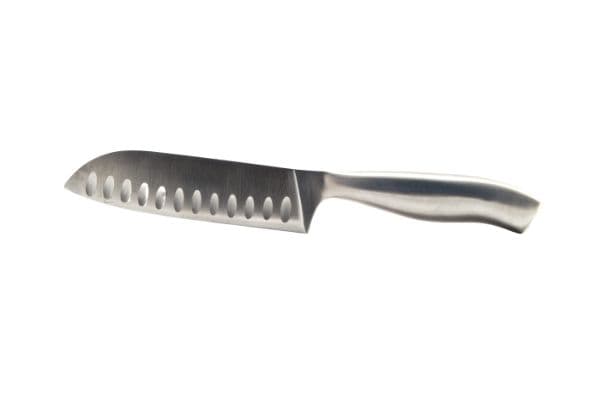
Weight: The ideal santoku kitchen knife should be lightweight, have a good balance, and be easy to use. A well-designed santoku knife will give you flexibility as you chop vegetables, slice bread, or whack meat. It will also feel comfortable in your hand. The santoku knife is often compact and easy to use, so it’s great for impromptu parties. It is easy enough to wield.
Over time, even the santoku has evolved. The classic style is made with a steel blade. Next up is a blade made of Damascus steel. And finally, there’s also a ceramic blade. Of course, true chefs are not satisfied with that and prefer steel, no matter how expensive it is!
While buying a santoku knife, go for a high carbon Japanese stainless steel or Damascus steel. A ceramic blade is probably not a good choice for a versatile knife like santoku.
What is the difference between Nakiri and Santoku?
| Features | Santoku | Nakiri |
| Cutting | Rocking, Straight Up and Down | Straight Up and Down |
| Length | 5-8 inch | 6-7 inch |
| Blade structure | Sheep-foot, Thin and Flat edge | Straight, Rectangular and Thin |
| Uses | Cutting fish, meat and vegetable | Specialist in cutting, mincing and dicing vegetables |
| Weight | 6.5 to 8.5 ounces | 7.5 to 9.4 ounces |
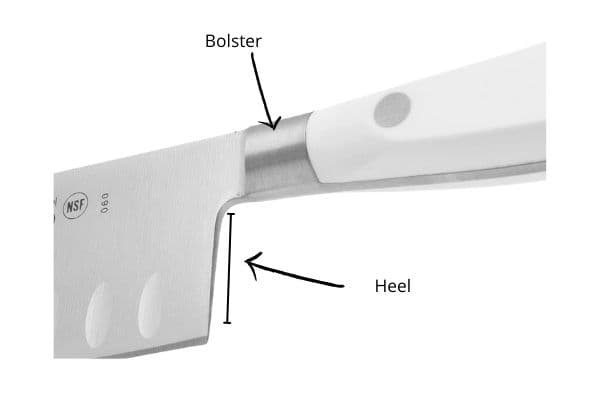
Frequently asked questions about santoku vs nakiri knife
Sould I get a Santoku or a Nakiri?
Go for a santoku knife if you wish to cut meat, vegetables, and fish or even fruits. If you want a knife especially for vegetables then Nakiri is the best choice.
What is a Santoku knife best for?
Santoku knife is used for cutting vegetables, fish and meat.
What is a Nakiri knife used for?
Nakiri knife is used for mainly cutting, mincing and dicing vegetables.
Can you use nakiri knives for cutting meat?
Nakiri knife is not suitable for cutting meat. It doesn’t have a pointed tip to penetrate between bones.
What angle do you sharpen a nakiri knife?
For best result sharpen your nakiri nife at 12-15 degrees on both sides. At 10 degrees it becomes thin and fragile.
Are Nakiri knives useful?
Yes, nakiri knives are very useful for cutting vegetables, both hard rooted and soft.
Can Santoku knife be sharpened?
Yes, santoku knives are easier to sharpen. We recommend a 10-15 degrees angle of sharpening. Use a whetstone for the best result.
Final thoughts: Santoku vs Nakiri knife
A Nakiri knife is best for cutting vegetables and it is quite different from a Santoku. On the contrary, Santoku is more similar to a chef knife – a versatile knife for cutting meat, fish and vegetables.
Buy one you need the most. Santoku is a 3-in-1 knife, with more varieties of use, and Nakiri is best suited for cutting greens.
Hope the concept is clear regarding Nakiri vs Santoku knife. If you have any questions, send us a mail or let us know in the comment.

